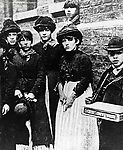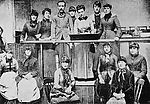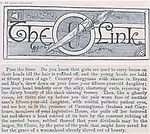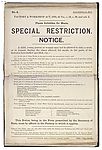 Match workers at the Bryant and May factory 1888
Match workers at the Bryant and May factory 1888 The Matchworkers' Strike Committee 1888
The Matchworkers' Strike Committee 1888 To the Shareholders of Bryant & May
To the Shareholders of Bryant & May  Slaved out of Beauty
Slaved out of Beauty Another case of Phossy Jaw - 1898
Another case of Phossy Jaw - 1898 Restriction Notice - Factory & Workshops Act 1878
Restriction Notice - Factory & Workshops Act 1878

In 1888, Besant, a journalist, discovered the conditions of workers at the Bryant and May match factory. She interviewed workers and published an article, "White Slavery in London", in "The Link". Workers were forced by the company to sign a statement denying Besant’s claims. When they said no, they were sacked. 200 immediately went on strike seeking support from Besant. Soon 1,400 workers were striking.
Besant exposed appalling conditions. Girls worked 14 hour days for 5 shillings (today approximately £19) a week. They were fined for talking, toilet breaks, dropping matches and lateness. Some paid for materials they needed to make matches. Heavy boxes were carried on their heads leading to hair loss. (See the article,“Slaved out of Beauty”).
The phosphorous led to yellowing skin, hair loss, and "phossy jaw", which started with tooth ache, then abscesses of the jaw, which were painful, unsightly and foul-smelling. The jawbones rotted and glowed greenish-white in the dark. Removal of the jawbones might save lives; otherwise "phossy jaw" caused brain damage or death. White phosphorous had already been banned in Europe; it wasn’t banned here until 1910.
Workers formed a Union and elected Besant the leader. A boycott of Bryant and May’s matches was called for in sympathizing newspapers. On the other hand,the Times and others blamed Besant for the dispute, accusing her of giving bad, misleading advice and talking “twaddle”.
Bryant and May threatened legal action, but none was taken. They also threatened that they would move the factory to Sweden where resources were cheaper, or that workers would be brought from Scotland. Marches, rallies and a strike fund were organized. Sympathy for the women increased, as it became clear that they were determined to help themselves. They refused to do collections saying “Poor as we are, we ain’t come to cadging yet.”
On July 21st 1888, Bryant and May made the following proposals; (1) abolition of fines, (2) abolition of deductions for paint, brushes and stamps, (3) rackers-out to be paid piece work (4) the packers to be paid threepence, (5) grievances to go to the managing directors without the intervention of foremen, (6) A breakfast-room for eating meals, (7) the Union should continue, and receive company recognition.
Agreement was reached. The Matchgirls' Union soon became the Matchmakers' Union, open to men and women. It only continued until 1903, but is seen as being one of the most important early unions, because it showed “unskilled” workers that they could organize themselves and stand up for their rights.
Rollover the captions in the box to see the available images in thumbnail format, click the caption to see the full-size image
| Reference: | 696 |
| Keywords: | |
| Archive Ref: | |
| Updated: | Thu 15 May 2008 - 1 |
| Interpretation written by | Jenny Ermoyenous |
| Author's organisation | Curatorial |
| Organisation's website |